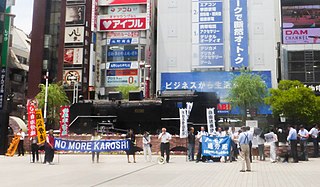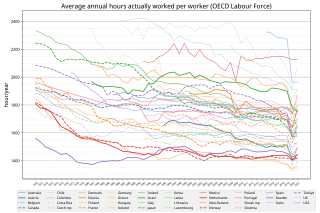Related Research Articles

Karoshi, which can be translated into "overwork death", is a Japanese term relating to occupation-related sudden death.
Employment is a relationship between two parties regulating the provision of paid labour services. Usually based on a contract, one party, the employer, which might be a corporation, a not-for-profit organization, a co-operative, or any other entity, pays the other, the employee, in return for carrying out assigned work. Employees work in return for wages, which can be paid on the basis of an hourly rate, by piecework or an annual salary, depending on the type of work an employee does, the prevailing conditions of the sector and the bargaining power between the parties. Employees in some sectors may receive gratuities, bonus payments or stock options. In some types of employment, employees may receive benefits in addition to payment. Benefits may include health insurance, housing, disability insurance. Employment is typically governed by employment laws, organisation or legal contracts.
Overtime is the amount of time someone works beyond normal working hours. The term is also used for the pay received for this time. Normal hours may be determined in several ways:
Productivity is the efficiency of production of goods or services expressed by some measure. Measurements of productivity are often expressed as a ratio of an aggregate output to a single input or an aggregate input used in a production process, i.e. output per unit of input, typically over a specific period of time. The most common example is the (aggregate) labour productivity measure, one example of which is GDP per worker. There are many different definitions of productivity and the choice among them depends on the purpose of the productivity measurement and data availability. The key source of difference between various productivity measures is also usually related to how the outputs and the inputs are aggregated to obtain such a ratio-type measure of productivity.
The economies of Canada and the United States are similar because both are developed countries. While both countries feature in the top ten economies in the world in 2022, the U.S. is the largest economy in the world, with US$24.8 trillion, with Canada ranking ninth at US$2.2 trillion.

Working (laboring) time is the period of time that a person spends at paid labor. Unpaid labor such as personal housework or caring for children or pets is not considered part of the working week.
Flextime is a flexible hours schedule that allows workers to alter their workday and decide/adjust their start and finish times. In contrast to traditional work arrangements that require employees to work a standard 9 a.m. to 5 p.m. day, flextime typically involves a "core" period of the day during which employees are required to be at work, and a "bandwidth" period within which all required hours must be worked. The working day outside of the "core" period is "flexible time", in which employees can choose when they work, subject to achieving total daily, weekly or monthly hours within the "bandwidth" period set by employers, and subject to the necessary work being done. The total working time required of employees on flextime schedules is the same as that required under traditional work schedules.

A part-time job is a form of employment that carries fewer hours per week than a full-time job. They work in shifts. The shifts are often rotational. Workers are considered to be part-time if they commonly work fewer than 30 hours per week. According to the International Labour Organization, the number of part-time workers has increased from one-quarter to a half in the past 20 years in most developed countries, excluding the United States. There are many reasons for working part-time, including the desire to do so, having one's hours cut back by an employer and being unable to find a full-time job. The International Labour Organisation Convention 175 requires that part-time workers be treated no less favourably than full-time workers.
Job security is the probability that an individual will keep their job; a job with a high level of security is such that a person with the job would have a small chance of losing it. Many factors threaten job security: globalization, outsourcing, downsizing, recession, and new technology, to name a few.
Many both in and outside Japan share an image of the Japanese work environment that is based on a "simultaneous recruiting of new graduates" and "lifetime-employment" model used by large companies as well as a reputation of long work-hours and strong devotion to one's company. This environment is said to reflect economic conditions beginning in the 1920s, when major corporations competing in the international marketplace began to accrue the same prestige that had traditionally been ascribed to the daimyō–retainer relationship of feudal Japan or government service in the Meiji Restoration.

Workforce productivity is the amount of goods and services that a group of workers produce in a given amount of time. It is one of several types of productivity that economists measure. Workforce productivity, often referred to as labor productivity, is a measure for an organisation or company, a process, an industry, or a country.
Japanese labour law is the system of labour law operating in Japan.

The Fair Labor Standards Act of 1938 29 U.S.C. § 203 (FLSA) is a United States labor law that creates the right to a minimum wage, and "time-and-a-half" overtime pay when people work over forty hours a week. It also prohibits employment of minors in "oppressive child labor". It applies to employees engaged in interstate commerce or employed by an enterprise engaged in commerce or in the production of goods for commerce, unless the employer can claim an exemption from coverage. The Act was enacted by the 75th Congress and signed into law by President Franklin D. Roosevelt in 1938.
Job sharing or work sharing is an employment arrangement where two people, or sometimes more, are retained on a part-time or reduced-time basis to perform a job normally fulfilled by one person working full-time. This leads to a net reduction in per-employee income. The people sharing the job work as a team to complete the job task and are jointly responsible for the job workload. Pay, holidays and working hours are apportioned between the workers. In some countries, systems such as pay as you go and PAYE help make deductions for national insurance, and superannuations are made as a straightforward percentage.
Work–life balance in the United States is having enough time for work and enough time to have a personal life in the United States. Related, though broader, terms include lifestyle balance and life balance. The most important thing in work and life is the personal ability to demonstrate and meet the needs of work and personal life in order to achieve goals. People should learn to deal with role engagement management, role conflict management and managing life needs to achieve balance. Balance is about how to properly achieve the desired work and life satisfaction and needs in a conflict situation.
The Labor policy in the Philippines is specified mainly by the country's Labor Code of the Philippines and through other labor laws. They cover 38 million Filipinos who belong to the labor force and to some extent, as well as overseas workers. They aim to address Filipino workers’ legal rights and their limitations with regard to the hiring process, working conditions, benefits, policymaking on labor within the company, activities, and relations with employees.

Employees who work overtime hours experience numerous mental, physical, and social effects. In a landmark study, the World Health Organization and the International Labour Organization estimated that over 745,000 people died from ischemic heart disease or stroke in 2016 as a result of having worked 55 hours or more per week. Significant effects include stress, lack of free time, poor work-life balance, and health risks. Employee performance levels could also be lowered. Long work hours could lead to tiredness, fatigue, and lack of attentiveness. As a result, suggestions have been proposed for risk mitigation.

The unemployment rate in the Republic of Korea as of December 2021 is 3.7 percent. Since its rapid globalization and democratization, the unemployment rate has been comparatively low compared to most OECD countries. This remains the case as of 2021. Being Asia’s fourth-largest economy, the country's booming exports have helped to maintain the unemployment rate very low by the standards of developed countries. There are several measurement differences between the standard of measurement set by the International Labour Organisation and the official measurement of unemployment in the Republic of Korea, set by Statistics Korea, that contribute to an inflated unemployment rate when compared to other countries that abide more strictly by the standard set by the International Labour Organisation.

South Korea has been a society that could not guarantee work–life balance historically and legally. But work–life balance in South Korea advanced when Warabel emerged as a neologism, changing the perception of people's work and their basic rights. There are two major movements: improving law and improving people's perceptions.
Overwork, also known as excessive work or work overload, is an occupational condition characterized by working excessively, frequently at the expense of the worker's physical and mental health. It includes working beyond one's capacity, leading to fatigue, stress, and potential health complications.
References
- 1 2 "South Korea Country Review". Business Source Complete: 275 – via EBSCOhost.
- 1 2 "Employment - Hours worked - OECD Data". theOECD. Retrieved 2016-12-03.
- ↑ David, Coates (2000). Models of Capitalism: Growth and Stagnation in the Modern Era. Polity Press. p. 7.
- ↑ Na, Sean (18 July 2016). "Business fears cut to working hours - South Korea".
- ↑ Chu-hŭi Chŏn, Yŏng-sŏn Kim, Chae-hyŏn Chŏng; et al. (2015). Uri nŭn wae irŏn sigan ŭl kyŏndigo innŭn'ga : sam ŭl sojin sik'inŭn sigan ŭi munjedŭl / Nodong Sigan Sent'ŏ kiho. Seoul: K'onan Puksŭ. p. 155.
{{cite book}}: CS1 maint: multiple names: authors list (link) - 1 2 3 4 5 Bae, Kiu Sik (2014). Employment relations in South Korea : evidence from workplace panel surveys. Hampshire: Palgrave Macmillan.
- ↑ Ryu, Geunpil (2014). "The cross-domain effects of work and family role stressors on public employees in South Korea". Review of Public Personnel.
- ↑ Korea Times (December 4, 2014). "Explaining low productivity".
- 1 2 "South Korea: monthly working hours by occupation 2019". Statista. Retrieved 2020-12-12.
- ↑ "Korean Productivity: Work & Life Balance | DHR International". www.dhrinternational.com. Retrieved 2020-12-12.